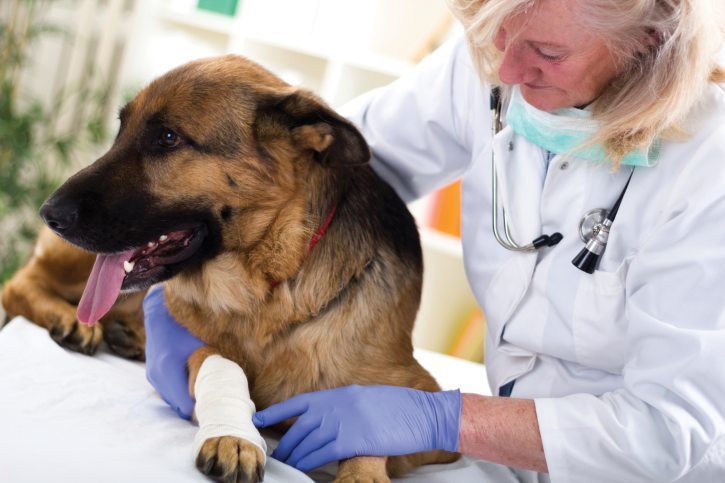O ur loyal, furry friends deserve the best care possible. Living a long a healthy life means knowing the diseases and injuries that can occur in your dog. Knowing the signs and symptoms is the first step to avoid complications and other health problems down the road. Here are the top dog diseases and injuries that could occur and how to avoid them:
ur loyal, furry friends deserve the best care possible. Living a long a healthy life means knowing the diseases and injuries that can occur in your dog. Knowing the signs and symptoms is the first step to avoid complications and other health problems down the road. Here are the top dog diseases and injuries that could occur and how to avoid them:
1. Ear Infections
A common problem in dogs can occur in the ear. Ear mites, bacteria, allergies, yeast, and hair that grow deep inside the ear canal cause ear infections. The most common symptoms include:
- Odor in the ears
- Shaking of the head
- Incessant scratching
- Redness inside the ear and ear canal
- Puffiness or swelling of the ear
- Discharge of any kind
- Lack of balance
If you see any of these signs or symptoms, take your dog to your veterinarian right away. Many times, a simple cleaning of the ear canal with some medication will clear it up quickly. It might require a regular cleaning of the ears on your part, however that simple step will go a long way in preventing future flare-ups.
2. Parasites
Parasites, such as roundworms, whipworms, tapeworms, and hookworms are quite common and need to be addresses as early as possible, especially in puppies. When you take your dog to your veterinarian, a fecal sample is usually required to check for any parasites. The signs and symptoms that your dog may have worms include:
- Loss of appetite
- Diarrhea
- A dry, rough coat
- Scooting their behind on the ground or floor
- Weight loss
- Overall unhealthy appearance
Treatment depends on the type of worms that are found and require an oral medication. Follow-up is extremely important to make sure all are gone. Treating worms on your own is not an option.
3. Fleas
One flea can turn into thousands of bugs that bite your dog and can make you both miserable in as little as three weeks. Your dog can pick up fleas any time they walk outside, no matter where you live. The good news is they are easy to treat quickly and effectively. The signs and symptoms of fleas include:
- Hot spots
- Hair loss
- Excessive biting, licking and scratching of the skin
- Dermatitis – allergies
- Tapeworms that are carried by fleas
- Little small black dots – flea dirt that appears on your dog’s skin
They can really make your dog feel uncomfortable and if left untreated, can lead to infections, allergies and even loss of blood making them anemic. Regular flea medication is usually the best answer as well as flea shampoo, topical liquids and sprays.
4. Soft Tissue Injuries And Sprains
Just like us, our dogs need regular exercise but during the winter months, this can be somewhat difficult. Unfortunately, our pets can lose their muscle tone and strength in just a few days. During cold weather and spending months indoors, muscles can weaken setting your dog up for sprains and injuries when warmer weather arrives.
 Before you head off to the dog park, warm your dog up with a slower walk. Be consistent with your walks by exercising him or her daily. This will help keep the muscles and ligaments healthy and strong to avoid any sprains and strains. If you live in a northern climate where exercising outdoors can be difficult, look for an indoor dog park or a warm water pool for dogs. Take your dog with you on cross-country skiing trips, play Frisbee, fetch or let them walk alongside you as you hike or jog.
Before you head off to the dog park, warm your dog up with a slower walk. Be consistent with your walks by exercising him or her daily. This will help keep the muscles and ligaments healthy and strong to avoid any sprains and strains. If you live in a northern climate where exercising outdoors can be difficult, look for an indoor dog park or a warm water pool for dogs. Take your dog with you on cross-country skiing trips, play Frisbee, fetch or let them walk alongside you as you hike or jog.
Treatment For Injuries
If you notice that your dog can no longer put weight on a leg or see signs of pain or swelling of the joint, then seek treatment from your veterinarian so you can rule out a dislocation or fracture. X-rays will be taken and activity should be restricted. Cold packs on the joint will help if they are applied three times during the first 24 hours. After that time period, use a warm, moist compress for the next 2-3 days.
Anti-inflammatories may be prescribed for your dog to reduce the swelling around the injured area, however be aware that if the pain is eliminated, your dog might start using the injured leg again. If confined or activity is restricted, then it should not be a problem. Allow at least 3 weeks for the healing to take place to avoid arthritis developing in the joints.
5. Diabetes
Obesity is becoming more prevalent among dogs of all ages. One of the biggest risk factors for developing diabetes is being overweight. However, it can be prevented. Your dog should exercise for at least 20 minutes or longer every single day. Add to that a high-calorie, high carbohydrate diet that is inappropriate for dogs and the risk of developing diabetes increases. Commercial pet formulas and feeding them human food doesn’t help the situation.
Both dogs and cats are require a high quality diet. Your dog’s GI tract may be very sensitive. Look for food that is moisture-rich and contains few carbohydrates and little or no grains. Dog Food Advisor is a great resource to help you find a high quality food to fit your dogs needs.
Some may thrive on a raw diet but you need to take precautions and do your research before making a drastic switch. Read our What You Need To Know About Raw Diets when starting your research.
6. Dental Disease
Teeth cleanings are done on a daily basis in most veterinary offices and that is because dental disease has increased significantly. It is especially common in small breeds such as the Yorkshire terrier, Maltese, Toy Poodle, Pomeranian and Shetland sheepdog.
Oral hygiene is the way to go with an appropriate diet that is preferably raw. Gnawing on raw meat acts like flossing and using a toothbrush for your dog. Seeing your veterinarian on a regular basis can help catch any changes in your dog’s mouth before a problem occurs. Dental bones work well to prevent tartar and plaque on your dog’s teeth plus keep their breath fresh.
Reviewed and approved by Dr. David L. Roberts, DVM
Images: Thinkstock









